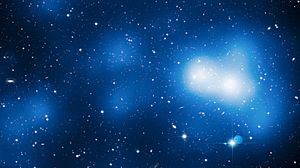Hercules–Corona Borealis Great Wall facts for kids
The Hercules–Corona Borealis Great Wall is the biggest known structure in the universe. Imagine a giant sheet made of galaxies! It's a huge group of galaxies all connected together.
This amazing structure is incredibly large. It stretches about 10 billion light-years long. That's 10,000,000,000 light-years! It is also 7.2 billion light-years wide and almost 1 billion light-years thick. It gets its name because it is found in the direction of the constellations of Hercules and Corona Borealis.
Contents
How Was This Giant Wall Found?
This massive structure was discovered in November 2013. Scientists found it by mapping something called gamma-ray bursts. These bursts are super powerful explosions from very distant, huge stars. They are the strongest explosions known in the universe!
A single gamma-ray burst can release more energy in a tiny fraction of a second than our Sun will in its entire 10 billion-year life. These bursts are quite rare. Only about one happens in a typical galaxy every few million years.
Gamma-Ray Bursts: Cosmic Beacons
Gamma-ray bursts come from extremely massive stars. These stars need a lot of material to form. So, when we see a gamma-ray burst, it tells us that there's a galaxy or a large amount of matter in that direction. It's like a cosmic beacon pointing to where galaxies are.
Between 1997 and 2012, astronomers used special robotic satellites. These satellites, named Swift and Fermi, looked for gamma-ray bursts. They also measured how much the light from these bursts was stretched, which is called their "redshift." Redshift helps scientists figure out how far away things are.
The Discovery Moment
When scientists mapped these bursts, they noticed something exciting. Fourteen gamma-ray bursts had very similar redshifts. They were also very close to each other in the sky. This was a big clue! It meant there was a huge group of galaxies and matter in that area.
By measuring these bursts, they found a super-large structure. It measured an incredible 10 billion light-years across. This was how the Hercules–Corona Borealis Great Wall was discovered!
How Big Is It Really?
To help you understand just how big the Hercules–Corona Borealis Great Wall is, let's compare it to some things you might know.
Our home galaxy, the Milky Way, is only about 100,000 light-years across. That's tiny compared to the Great Wall! The distance from the Milky Way to our closest large galaxy neighbor, the Andromeda Galaxy, is about 2.5 million light-years. Still much smaller.
Before this discovery, the largest known structure was the Huge-LQG. That stands for the Huge Large Quasar Group. It was about 4 billion light-years long. The Hercules–Corona Borealis Great Wall is more than twice that size!
Challenging Our Understanding of the Universe
The discovery of the Hercules–Corona Borealis Great Wall actually goes against a very important idea. This idea was proposed by Albert Einstein. It's called the cosmological principle.
What is the Cosmological Principle?
The cosmological principle suggests that the universe is mostly the same everywhere. If you look at any two very large regions of the universe, they should look quite similar. This is true even if those regions are very far apart. Scientists thought that the largest structures should be around 1.2 billion light-years. This idea assumes that matter spread out evenly after the Big Bang.
However, the Hercules–Corona Borealis Great Wall is about eight times larger than this limit. This means it directly challenges the cosmological principle. It makes scientists rethink how matter is spread out in the universe.
A Mystery of Formation
This giant structure also makes scientists wonder about how the universe evolved. We see the Hercules–Corona Borealis Great Wall as it was 10 billion years ago. This is because its light has taken 10 billion years to reach us. At that time, the universe was only about 13.8 billion years old.
The problem is that 13.8 billion years seems too short for such a giant structure to form. Even Istvan Horvath, one of the scientists who discovered it, admits he doesn't know how it could have formed so quickly. For now, the existence of the Hercules–Corona Borealis Great Wall remains a big mystery for scientists who study the universe.
Images for kids
-
Artist's interpretation of a gamma-ray burst, like the ones used to map the wall.
See also
 In Spanish: Gran Muralla de Hércules-Corona Boreal para niños
In Spanish: Gran Muralla de Hércules-Corona Boreal para niños



